
36 Le Dinh Hieu
DESIGN OF ADAPTIVE CONTROLLER TO IMPROVE STABILITY FOR
ELECTRIC VEHICLES
Le Dinh Hieu*
School of Engineering and Technoloy - Hue University, Vietnam
*Corresponding author: ledinhhieu@hueuni.edu.vn
(Received: July 16, 2024; Revised: August 11, 2024; Accepted: September 26, 2024)
DOI: 10.31130/ud-jst.2024.336
Abstract - Currently, with outstanding advances in automated
driving technology, modern vehicles with a variety of electronic
control systems help improve traffic safety. One is the electronic
stability adaptive control system that ensures the electric vehicle stays
on track even in unpredictable situations such as driving on slippery
roads, sudden movements, and changing direction of driving on the
highway. The article focuses on developing an adaptive electronic
stability controller for electric cars modelled on software Matlab-
Simulink. Design a vehicle stability controller within the scope of
surveying the slippage of four tyres in the stability limit ellipse
corresponding to the driving angle when using a fuzzy adaptive
electronic stability controller (Fuzzy-ESC) compared to compared
with the electronic stability control swarm optimization controller
(PSO-ESP), it minimizes skids and vehicle rollovers during obstacle
avoidance, lane changing, corner entry/exit and sudden acceleration.
Key words - Electronic stability control (ESC); Electronic
Stability Programs (ESP); Fuzzy-ESC; PSO-ESP; Active safety
control systems; EVs.
1. Overview of electronic stability control for electric
vehicle
Nowadays, every new car on the market has many
electronic control systems serving many different
purposes. The focus of the control systems is to ensure the
safety of electric vehicles (EVs) when operating on the
road. As we know, sometimes the driver loses
concentration and sometimes makes mistakes, but when
driving a car, it does not allow any mistakes that lead to
serious consequences and are related to human life [1].
Automatic control systems help the driver to handle
dangerous situations that the driver cannot handle by
himself due to loss of concentration or sudden changes that
human psychology cannot respond to in time [2-5].
The electronic stability control system is also known by
many different names such as ESP (Electronic Stability
Program) [2] or DSC (Dynamic Stability Control), ESC
(Electronic Stability Control) [3], depending on the car
manufacturer's name for this system. The control system
can detect loss of steering control and resolve it by
applying braking torque to each wheel, and some
manufacturers integrate an additional engine power
management function. In addition, the electronic stability
control helps the car avoid oversteer or understeer.
The technology of the electronic stability control system
is based on the ABS (Anti-Locking Brake System), which
allows the system to break each wheel individually. Even the
TCS (Traction Control System) often acts as a secondary
function of the ESP. However, compared to the ABS and the
TCS that improve the car's ability to turn, the ESP system
itself helps reduce the loss of control of the car's steering.
Regarding the effectiveness of the ESP controller, the
US National Highway Traffic Safety Administration
published a study in 2006, that the use of ESP reduces fatal
vehicle crashes by 35% for cars and 67% for family sport
utility vehicles (SUVs), data provided from various studies
referred to in [3]. ESP systems have been mandatory on all
passenger vehicles in the United States since 2012 and in
the European Union since 2014.
The decision algorithms of ESP mainly have the following
forms: PID feedback control, neural network control and
optimal control [1]. The paper [2] used the AFSA and SA
methods to update the PID parameters to control the ESP
system to change the direction of the truck at the expected yaw
velocity. The robust fuzzy controller [3-8], the optimal
stabilization based on parallel distribution compensation was
designed using the Takagi–Sugeno fuzzy model of electric
vehicles with the fuzzy model stability feedback gain,
optimizing the longitudinal velocity state stability control
parameters for automobiles [6]. Parameter optimization of
intelligent controllers [9] and fuzzy sliding mode controller
(FSMC) were proposed to solve the instability caused by
nonlinear characteristics when turning or changing lanes at
high speeds [10]. Fast online parameter estimation of the
vehicle's cornering stiffness coefficient using deep learning
algorithms to control the state stability of automobiles [11].
The main purpose of this paper is to develop an
electronic stability control algorithm for automobiles with
a nonlinear dual-track model. The ESP algorithm is used to
control the stability of the vehicle by applying braking
torque, so it may not be able to maintain the longitudinal
speed of the vehicle, so it needs to be improved to increase
stability [1]. For the above reason, the cruise control
algorithm can be added to work with ESP, so it is called
enhanced stability control ESC, with the above approach,
it is possible to avoid using two different control systems
at the same time on the automobile. Furthermore, ESC
controls the torque for each individual wheel [5], so the
proposed research topic to improve the control quality
applies modern algorithms such as adaptive fuzzy control,
multi-objective optimization algorithm PSO [6].
2. Dynamics Equation of Electric Vehicles
2.1. The twin-track model of EVs
2.1.1. Modelling the system on a dual track model
The vehicle dynamic model is divided into four parts:
chassis, transmission, drive system and body, as shown in

ISSN 1859-1531 - THE UNIVERSITY OF DANANG - JOURNAL OF SCIENCE AND TECHNOLOGY, VOL. 22, NO. 12, 2024 37
Figure 1. In the model shown in Figure 1, the parameters:
drive torque
m
M
(Nm), brake torque
b
M
(Nm) and
regenerative brake torque
b
M
(Nm) on each wheel and the
steering angle
of the two front wheels (with the same
magnitude) are selected as inputs to the steering system or
to the control system. In addition, the model also takes into
account external disturbances. Survey and model the road
surface on which the car moves with different roughness,
leading to different values of the coefficient of friction µ
between the tyres and the road surface [7]. The impact of
wind is also modelled by the torque acting on the body
when the car moves.
Figure 1. Diagram of the dual track model
The nonlinear dual-track model [2] of an electric
vehicle is used for investigation in Figure 1, which
represents the actual states of the vehicle when operating
on the road.
Figure 2. Data on tyre lateral forces
Modelling the lateral forces of tyres when moving on the
road used to investigate electric cars is shown in Figure 2.
2.1.2. The balanced elliptical model of the tire
The tire model describes the tire contact surface with a
relatively small area directly interacting with the road
surface; through two important variables: the slip
coefficient λ and the lateral slip angle α (rad) [11, 12]. Each
tire of the wheel is described by the following correlation
equation [13]:
( )
,
,
max ,
i x i
i
i x i
rv
rv
−
=
(1)
,
,
arctan yi
i
xi
v
v
=
(2)
Where:
r
is the wheel radius (m),
,yi
v
is the angular
velocity (rad/s) of the i-th wheel,
,xi
v
(rad/s) and
,yi
v
(rad/s)
are the speeds of the i-th wheel-center of the wheel along
the x and y axes respectively.
The mathematical model of Pacejka [8] to model the
interface between the tyre and the road surface with the
shape factor parameters, two input parameters λ, α (with
λ: slip coefficient and α: lateral slip angle). Pacejka's
mathematical formula approximately describes the
characteristics of important forces and moments
generated at the contact area between the tyre and the road
surface, including longitudinal force, and lateral moment.
While the slip coefficient is used to calculate the
longitudinal force, and lateral force [14], the lateral
moment is a function of the lateral slip angle α of the tyre.
For the input slip variable x and shape factors A, B, C,
and D; the formula in its most basic form to calculate the
force
L
F
(N) is as follows [13, 15, 18]:
( )
( )
sin arctan arctan( )
L x x x
F A C B D B B
= − −
(3)
Figure 3. Traction ellipse of EVs tires
The paper applies the combined slip method with the
friction ellipse used described in detail [16], and shows the
dependence of the longitudinal and lateral forces of the tire
described by the Kamm circle [17], also known as the
traction circle or friction circle. The longitudinal force
x
F
(N), the lateral force
y
F
(N) and the normal force
z
F
(N),
the friction coefficient µ are then constrained by the
following inequality:
22
x y z
F F F
+ =
(4)
However, the practice and the model (4), one considers
an ellipse instead of a circle and the ellipse is described by
the following inequality:
2
2
22
, max , max
1
y
x
xy
F
F
FF
+
(5)
If the expression of
x
F
(N) and
y
F
(N) on the left side
of equation (5) 1, the tyre still maintains its grip on the
road surface. On the contrary, if the result of the expression
on the left side of (5) >1, the tyre will lose its grip on the
road surface and slip. The ellipse representing the tyre
traction limit is shown in Figure 3.
𝐹x[N]
•
•
Fy, max
Fy[N]
𝐹𝑥,𝑚𝑎𝑥
•
𝐹i
•
𝐹x, i
𝐹y,i
Turn right
Turn left
Brake
Acceleration
The tyre area
maintains grip
Tire slip area
Tire grip
margin
n
Ellipse limits
tire traction
Lốp

38 Le Dinh Hieu
Figure 4. Investigation of the friction coefficient µ perturbation
for both left tyres of the EVs
The coefficient of friction µ from equation (4) is
assumed to be equal to 1 in the usual case with a fairly
sticky road surface. Reducing its value independently for
each wheel simulates driving on a slippery road, which µ
is considered a variable causing external disturbances to
the EVs, as shown in Figure 1. The effect of µ is
determined by simulation with the situation where the car
starts to turn left with a constant yaw angular velocity and
a constant longitudinal velocity at the centre of gravity of
the EVs
C
V
. At that time, the road surface µ at the two left
wheels suddenly decreased to µ=0.2, leading to a decrease
in the yaw ratio, causing the driver to understeer a little, as
shown in Figure 4. The Figure 4.a) shows that the friction
coefficient is equal to 1 and then decreases to 0.22. At the
time from 4-6(s), the velocity along the Yaw axis changes
from 0.4(rad/s) at time 4(s) and decreases to 0.35(rad/s),
then recovers to 0.4(rad/s) at time 6.4(s).
2.2. The equation describing the body of EVs
Another important part of the dual-track model is the
equations describing the vehicle body. Since it is modelled,
the EVs use Newton-Euler equations, which have the
following general vector form:
()J J M
+ =
(6)
Where:
J
(kg.m2) is the moment of inertia matrix of
the vehicle body,
(rad/s) is the angular velocity vector
of the vehicle body and
M
(Nm) is the moment vector. The
right side of equation (6) is rewritten as:
4
1
() i i A
i
J J r F M
=
+ = +
(7)
Where:
i
r
(m) is the position vector of the centre of the
i-th wheel and
i
F
(N) is the vector of forces acting on the
i-th wheel;
A
M
is the vector of external torques caused by
aerodynamic forces.
While the first two elements of the vector (
ii
rF
) are
always considered to be zero, the third element is an
aerodynamic torque disturbance acting inward (7) and
Figure 1.
2.3. Transmission driver systems
In EVs, to save energy, increase efficiency, reduce
energy consumption, occupy less space, be light in weight,
and require less maintenance [15], the permanent magnet
rotor synchronous motor (PMSM) is one of the suitable
solutions chosen as the main drive motor for each wheel.
The PMSM drive system drives the main, braking torque,
and regenerative braking torque for each wheel [14] and is
modelled by the following equation:
. , , ,i i m i b i r i x i
J M M M r F
= − − −
(8)
Where:
i
J
(kg.m2) is the moment of inertia of the i-th
wheel and
i
(rad/s) is angular velocity.
.mi
M
(Nm),
,bi
M
(Nm) and
,ri
M
(Nm) are the main driving torque,
braking torque and regenerative braking torque acting on
the i-th wheel, respectively,
r
(m) is the wheel radius and
,xi
F
(N) is the longitudinal force acting on the i-th wheel.
In the paper, only forward motion is considered so the
torque is always positive to satisfy equation (8).
In the implementation of the torque limit simulation
actuator from equation (8), we have the torque required
from the driver or the control system as input. The
modelling of the drive system needs to ensure the accuracy
between the numerical simulation and the real physical
drive system, so the input signal saturation and delay model
have been added to the modelling of the control system.
The PMSM motor chosen as the drive device for each
wheel has an upper limit of the driving torque saturation
with the i-th wheel:
.,m d i
M
(Nm) is determined by the
maximum torque
.maxm
M
(Nm) or by the maximum power
,maxm
P
(kW) [5], depending on the angular velocity of the
i-th wheel
i
, according to the equation:
, max
.,
m
m d i
i
P
M
=
(9)
Assuming the speed limit of the dual carriageway
model is
( / )
m
v m s
,
.maxm
P
(kW) can be calculated using the
drag equation as follows:
3
.max
1
2
m D m
P C A v
=
(10)
Where: ρ is the air density,
D
C
is the drag coefficient
and A is the frontal area of the vehicle (
2
m
) when
substituting the values into (2.10) and we can calculate
( )
, maxm
PkW
and
.max )·(
m
MNm
.
The required braking torque is divided into two
branches if regenerative braking is used. The regenerative
braking will satisfy the demand as much as possible by
saturating it within its limits. Then, the saturation signals
will be subtracted from the required braking torque, and fed
into the classical braking system with the upper saturation
limit being
( )
.max ·
b
MNm
.
Regenerative braking is essentially a vehicle-driven
electric motor that turns into a generator in the event of a
downhill situation. So instead of applying driving torque
to the wheels, the wheels will rotate the motor themselves
and convert the kinetic energy of the wheels into
electrical energy stored back into the vehicle's battery.
Applying braking torque to the wheels is because the
wheels lose kinetic energy. Regenerative braking is much

ISSN 1859-1531 - THE UNIVERSITY OF DANANG - JOURNAL OF SCIENCE AND TECHNOLOGY, VOL. 22, NO. 12, 2024 39
more regenerative than using conventional braking, as it
not only recovers the used energy but also does not
pollute the environment, unlike conventional braking,
which releases microscopic wear particles during braking
[6]. The upper saturation limit of the required
regenerative braking torque is similar to that of the motor,
but only takes into account 40% of
.maxm
M
and
,maxm
P
due
to its efficiency. Furthermore, at low speeds, the
regenerative braking torque is further limited [7] and the
saturation of the regenerative braking torque is shown in
Figure 5.
The delay of each actuator can be modelled by a first-
order transfer function as follows:
1
() 1
Gs s
=+
(11)
Where: τ is the time constant, the magnitude represents
the delay. The electrical time constant 2(ms) is chosen for
the main driving electric motor of the drive system, while
the mechanical time constant of the drive system is
included in the wheel inertia moment model. The time
delay of the braking system is slightly larger, so its time
constant is set to 22(ms).
3. Development of EV stability control algorithm
3.1. Design of reference model EVs
The reference signal set is designed to select
appropriate reference signals from the model for the
control system. In addition to the vehicle speed deviation
and yaw angle deviation generated by both the vehicle
kinematic model and the data lookup from the parameter
table, the vehicle speed along the body at VCG is input.
The control signal is based on the magnitude of the
vehicle speed measured from the dual-track model, the
reference controller will automatically select the
“appropriate speed deviation” and yaw angle of the
vehicle. When the vehicle drives forward at a speed within
the range
( )
0 0.5 /ms
, the signals are fed back from the
vehicle kinematic model. Conversely, at the vehicle speed
( )
0.5 /
x
v m s
, the vehicle kinematic model is taken from
the model parameters as shown in Figure 5.
Figure 5. Signal reference diagram of the EVs model
3.2. The PSO-ESP adaptive controller
The PSO-ESP adaptive electronic stability controller
applies the PSO feedback optimization algorithm based on
the increase or decrease of the torque bias, which is
achieved by applying braking torque to both left and right
wheels. Since the torque bias rate is the only quantity
measured and implemented for vehicles with a propulsion
system, regenerative braking cannot be used. The torque
bias is measured from the dual-track model and subtracted
from the reference deviation from the vehicle model to the
PSO adaptive swarm controller. If the generated torque
bias is positive, the required braking torque is equal to the
torque that would be applied to both left wheels of the
vehicle. On the other hand, if the generated torque bias is
negative, it is multiplied by -1, which turns it into the
required braking torque applied to both right wheels of the
vehicle. The logic block is depicted in Figure 6 and is
limited in its implementation by saturation blocks
(Positive, Negative).
Figure 6. Modelling of the PSO-ESP adaptive swarm controller
of the cabinet electrical balance system on Simulink
Figure7. Principle of PSO-ESP controller
An energy function that takes PI parameters as input
values and returns the energy value of the PI-driven model
as its output has the format:
The optimization problem is described in terms of
energy functions and the goal of the optimization
algorithms is to minimize the value of the objective
function [20]:
( )
( )
( )
( ) ( )
1 . .
p ss s r
F exp M E exp T T
= − − + + − −
(12)
(1 ).( ) .( )
P SS s r
F e M E e T T
−−
= − + + −
where: F: Fitness objective function; Mp: Peak crossing; Ts:
Setup time; Tr: Rise times, and β: Scaling factor (it depends
on the designer's choice). We take the scaling factor
β = 0.5 and Ess is calculated as follows:
Ess = 1/(1+dcgain(Model_Vehicle)) (13)
Objective function [F]= Fittness(Kp, Ki) (14)
Since the PSO-ESP controller is not always active and
only intervenes when it detects a significant loss of steering
control of the vehicle [15], a dead zone is added. When the
PSO-ESP has an absolute value of the difference between
the measured yaw rate and the reference yaw rate lower
than
( )
0.035= /
ESP rad s
, and instead sets the required
braking torque to zero.
Model parameter
lookup table
Reference
sample
model
𝑣x
Dynamic model of
EV
𝛿
𝛽
𝐿𝑇
𝛽
kin
𝜓
kin
𝛽
ref

40 Le Dinh Hieu
The first requirement is that the control system must
react promptly when the steering control is lost, which will
help to minimize the deviation value. However, a lower
value will make the PSO-ESP transition too frequent,
which is difficult to implement in practice, so the
1( )
min ms
=
delay is added to the control process to reduce
the transition and make it easier to apply. The deviation
torque generated
()M Nm
from the braking torque applied
to one front wheel and one rear wheel on the same side of
Figure 7.
3.3. Electronically stabilized Fuzzy logic controller
(Fuzzy-ESC)
The Fuzzy-ESC (Fuzzy logic - Electronic stability
control) controller, applies an intelligent algorithm to
independently control each wheel torque. Compared with
the Fuzzy-ESC stability controller [16-18]. The Fuzzy-
ESC controller is always active because it not only controls
the braking torque but also the transmission torque.
Adaptive electronic stability controller includes the
function of both Fuzzy-ESC cruise control regenerative
braking system and angular velocity controller of each
wheel.
First, perform the conversion of the longitudinal speed
of the vehicle body at
C
V
to the longitudinal speed of each
wheel on the fixed frame of the vehicle body. Perform the
next conversion of the longitudinal speed to the fixed
frame with the car wheel to simplify, with a small steering
angle, this conversion has almost no impact on the
system. If
,x
CV
V
is the longitudinal speed at
C
V
and
,x
iV
W
is the longitudinal speed of the i-th wheel in the fixed
frame of the vehicle body, then for the reference signal as
follows:
,,
,,
x ref x ref
i V C V tr ref
W V s
= −
(15)
,,
,,
x ref x ref
i V C V ph ref
W V s
= +
(16)
With
1, 3i
.
When
2, 4i
, where
tr
s
and
ph
s
are the horizontal
distances from
C
V
to the left and right wheels, respectively.
The same applies to the measured signals from the dual-
track model, when we equal all the indices of the reference
model in equations (15) and (16) to
ref
represent the
instantaneous variable state of the system, we now
represent it as Figure 9.
The controller is applied to each wheel. Where
,
,,
x x ref
i V i V eWW
− =
and the deviation
e
are fed into the
fuzzy logic controller, the output signal of the
proportional controller gives the slip ratio λi. The slip
ratio is then saturated with the lower limit
,0.1
i min
=−
and
the upper limit
, 0.1
i max
=
. Depending on
,
,xm
iV
W
and
,im
,
the measured angular velocity of the i-th wheel is
calculated, the reference angular velocity is calculated for
further control, and the calculation is derived from
equation (1).
Figure 8. Transformation of the coordinate system from
the four tyres to the centre of the EV
If
,
,,
xm
i V i m
Wr
(
r
(m) is the radius of the wheel) and
,
,0
xm
iV
W
, then we have the following expression:
,
,
,(1 )
xm
iV
i ref
i
W
r
=−
(17)
Conversely, if
,
,,
xm
i V i m
Wr
and
,
,0
xm
iV
W
, then we
have the following expression:
,
,
,
(1 ) xm
i i V
i ref
W
r
−
=
(18)
We consider the forward direction of the vehicle so the
equations for
,
,0
xm
iV
W
, the two equations (15) and (16)
differ only in the plus and minus signs. The measured
angular velocity of each wheel is then subtracted from its
reference value from the sample model.
Figure 9. Schematic of the Fuzzy-ESC intelligent controller
Using the Fuzzy logic control applied to the closed-
loop controller [16]. When the output signal of the fuzzy
logic controller is positive, it represents the required
driving torque. On the other hand, if the output signal of
the fuzzy logic controller is negative, it is the required
braking torque. Therefore, the output signal of the fuzzy
logic controller is multiplied by -1 before being transmitted
to the regenerative braking system or braking system as
𝛿
𝛿
𝜓>0
𝑠tr
𝑠ph
𝑉𝐶x
𝑥
𝑉𝐶y
𝑦
𝑊1
𝑦1
𝑊1
𝑥1
𝑊
2
𝑥2
𝑊3
𝑥3
𝑊4
𝑥4
𝑊2
𝑦2
𝑊3
𝑦3
𝑊4
𝑦4
𝑊
1
𝑣𝑥1
𝑊
2
𝑣𝑥2
𝑊3
𝑣𝑥3
𝑊4
𝑣𝑥4
𝑉𝐶
𝑣
𝑥
The
Fuzzy-
ESC
Control
Model
of
double
-track
electric
vehicle
𝑀
m,d
𝑣x
𝜓
𝑀
b,d
𝑀
r,d
Model
parameter
lookup table
Reference
sample
model
𝑣x,
𝑟𝑒𝑓
Dynamic
model of EV
𝛿
𝛽
𝐿𝑇
𝛽
kin
𝜓
kin

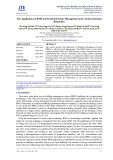

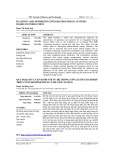

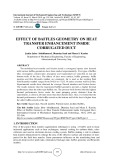
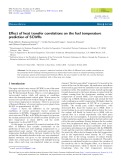
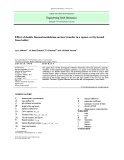
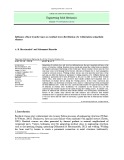
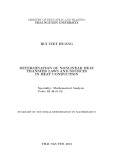







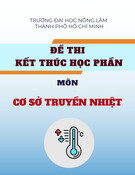

![Ngân hàng trắc nghiệm Kỹ thuật lạnh ứng dụng: Đề cương [chuẩn nhất]](https://cdn.tailieu.vn/images/document/thumbnail/2025/20251007/kimphuong1001/135x160/25391759827353.jpg)






